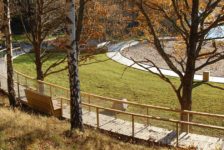SWA Group design Sands Bethwork at Bethlehem, Pennsylvania, USA. We have seen how landscape design can create an oasis in the desert and how a temporal landscape installation can promote consciousness about the constant exploitation of the land. Landscape design can also be used in recovery. This type of project, such as the recovery of the Thames River, is responsible not only for the natural recovery of a land mass, river, or mountain, but also can be a catalyst to regenerate societies, economic markets, and social roles. Human activities can be harmful to the Earth; many times we have seen how places once occupied by factories or houses are abandoned and become sites without any living organism. The Sands Bethworks, a project consisting of a new casino, hotel, museum, and mixed-use retail, has been developed in Bethlehem, Pa. The project promoted the recovery of land that was considered a residual place and was affected by previous mineral-mining activity. As the mining economy dwindled, the industry left behind empty and abandoned buildings – as well as contaminants and toxins.
The primary goal of the 20-acre landscape project was the recovery of the natural vegetation and the zone and the conservation of the building as a reminder that every place can be returned to its original status. To do this, SWA Group used a lot of sustainable methods. Existing Problems and Design Solutions The contamination of the soil became the main problem to solve. SWA landscape architects and local authorities found out that the ground of the factory presented high levels of heavy metals and toxic compounds and a serious quantity of petroleum products. Despite the decreasing activity of the mineral industry, the amount of toxic elements were incrementing. The quantity of soil contaminated was around 375 tons, inside the factory site. Another factor to consider is the water pollution that any mineral activity causes. Both problems were considered by the SWA Group as an opportunity to change the conception of parks design. At the Sands Bethwork design project, SWA architects used bioswales that are supposed to intercept runoffs and storm water over 11 acres of land, functioning as natural water purifiers. Another great factor in the Sands Bethwork design is the vegetation’s green palette. After removing all of the contaminated soil from the site, the construction team found out that the soil was also contaminated with highs levels of alkalines, which can cause chlorosis in plants (a process in which leaves produce insufficient chlorophyll and the leaves have a pale or yellow color). Because of this, the selection of specific plants — such as shrubs, trees, and grasses — had to be part of the solution. The new vegetation consists of species that are alkaline-tolerant, such as evergreen plants, and species that can clean up soil through phytoextraction and phytodegradation, like birch and juniper. The importance of respecting the history of the site by maintaining its unique industrial setting was fully recognized by the development team. To unify both new and old site conditions, the design followed the lines of the trestle structures throughout the site, creating order based upon historical precedence. At the entrance of the site, a steel structure is located as a remnant of what was the major activity for almost 100 years in Pennsylvania. Finally, the illumination project is also focused on the factory building, creating a unique night image of what was considered a useless building. The landscape design combines sustainable methods used to recover runoffs and storm water, the plant vegetation palette, and the respectful aesthetic toward the building — all together a good representation of how form and function are always simple but correct. See also: Top 10 Reused Industrial Landscapes Article written by Luis Eduardo Guísar Benítez Published in BlogLogin
Lost Password
Register
If this is your first time on the new site, please click "Forgot your password?". Follow the steps to reset your password. It may be the same as your old one.

















